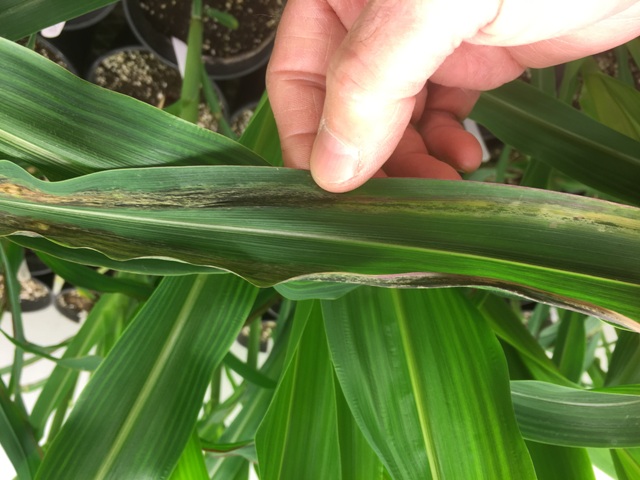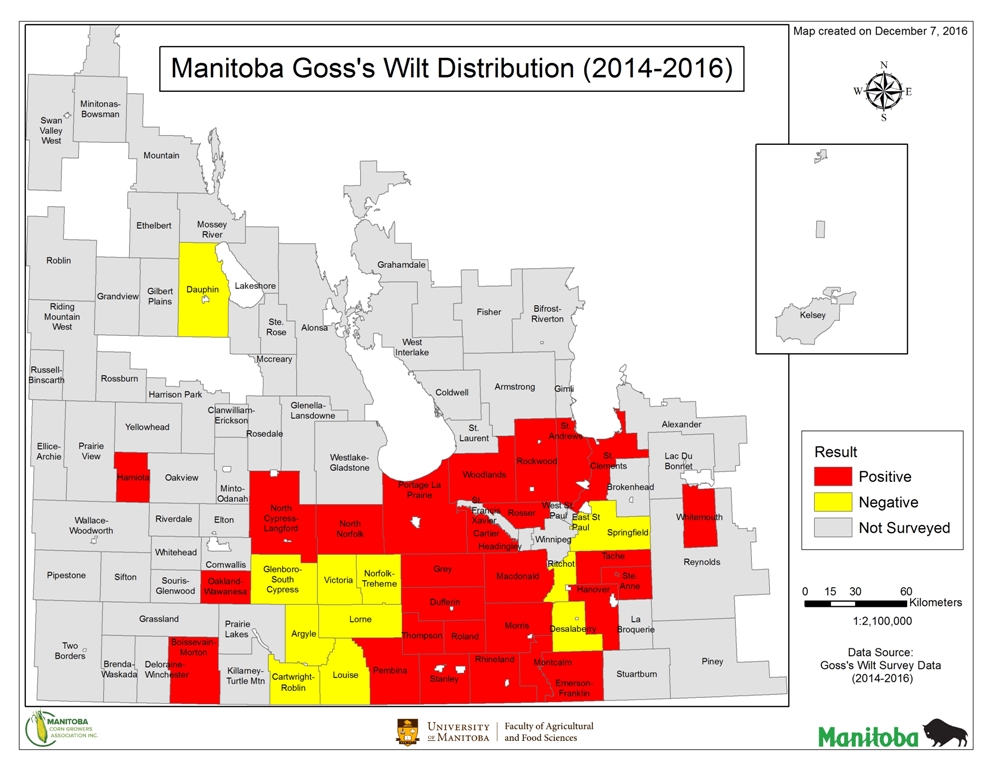This page is archived. We will no longer be updating the information, but it can be used for research or reference purposes.
Goss’s wilt distribution in Manitoba
Goss’s wilt is a bacterial disease of corn. It is caused by gram positive bacteria, Clavibacter michiganensis subsp. nebraskensis (CMN). This disease can cause both foliar symptoms and systemic wilt of corn.
Sand blasting, injury due to strong winds and hail damage can contribute in development of Goss’s wilt infection. Typical foliar symptoms include water soaked lesions giving freckled appearance to the leaves. These lesions may exhibit some localized red discoloration and necrotic tissue. The lesions may have sticky exudates which when dry gives shiny appearance to the infected leaves. Corn is susceptible to Goss’s wilt at all stages of development, but foliar symptoms usually appear in the field during late August to early September.

Figure 1: Goss’s wilt symptoms on artificially inoculated corn leaf
Photo courtesy of the Daayf lab, University of Manitoba
A first confirmed case of Goss’s wilt in Manitoba was first reported in 2009 near Roland. In the recent years, this disease has been reported in other corn growing areas in Manitoba.
In 2016, a total of one hundred and forty two corn fields were surveyed by Manitoba Agriculture in partnership with Manitoba Corn Growers Association and University of Manitoba. A total of fifty nine fields tested positive for Goss’s wilt disease. In addition to fifty nine positively identified fields during 2016 Goss’s wilt disease survey, one field in the RM of Portage la Prairie, two in the RM of Oakland and one in the RM of North Cypress-Langford were also found to be positive for Goss’s wilt disease.The identifications were made based on visual identification and/or PCR assay
Table 1. Comparison of Goss’s wilt detections in different rural municipalities from 2014-2016
RM |
2014 |
2015 |
2016 |
Boissevain-Morton |
n/a |
n/a |
+ |
Cartier |
n/a |
n/a |
+ |
Dufferin |
+ |
+ |
+ |
Emerson Franklin |
- |
+ |
+ |
Grey |
- |
+ |
+ |
Hamiota |
n/a |
n/a |
+ |
Hanover |
- |
+ |
+ |
Macdonald |
- |
- |
+ |
Montcalm |
+ |
+ |
+ |
Morris |
+ |
+ |
+ |
Norfolk-Treherne |
+ |
+ |
- |
North Cypress-Langford |
- |
n/a |
+ |
North Norfolk |
- |
+ |
+ |
Pembina |
n/a |
n/a |
+ |
Portage la Prairie |
+ |
- |
+ |
Rhineland |
+ |
+ |
+ |
Ritchot |
- |
+ |
- |
Rockwood |
n/a |
n/a |
+ |
Roland |
+ |
+ |
+ |
Rosser |
n/a |
n/a |
+ |
St. Andrews |
n/a |
n/a |
+ |
St. Clements |
n/a |
n/a |
+ |
Stanley |
+ |
+ |
+ |
Ste. Anne |
- |
- |
+ |
Tache |
n/a |
- |
+ |
Thompson |
+ |
n/a |
+ |
Whitemouth |
n/a |
+ |
+ |
Woodlands |
n/a |
n/a |
+ |
Oakland |
n/a |
n/a |
+ |
+ Positive – Negative n/a Not Surveyed

The map shows the cumulative results of the 2014, 2015 and 2016 Goss’s wilt surveys. The rural municipalities (RM) with positive and negative detections have been highlighted in red and yellow respectively. An RM highlighted in red indicates that at least one field in this RM tested positive. The RM highlighted in yellow indicates that this RM tested negative for ONLY the fields that were surveyed. Only a fraction of corn fields were surveyed in 2015 in Manitoba.
If Goss’s wilt is suspected, a sample can be submitted to Manitoba Agriculture’s Crop Diagnostic Laboratory by completing the Diagnostics for Crop, Insects and Weeds form (PDF 127 KB).
Management Strategy
Goss’s wilt is a bacterial disease and fungicides DO NOT work against this disease. Crop rotation and corn residue management helps in managing this disease. Some varieties may be more tolerant to Goss’s wilt.

